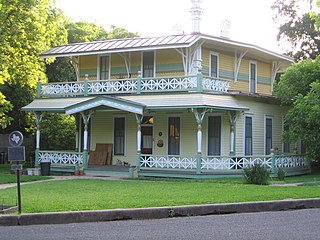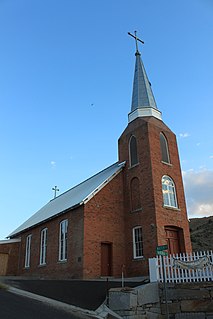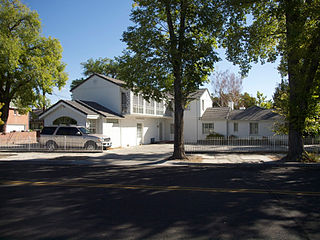
The Shadow Lawn Historic District is a historic district in central Austin, Texas that boasts a cohesive collection houses built in the southeast portion of Hyde Park during the late 1920s and 1930s.

The Georgia State Railroad Museum is a museum in Savannah, Georgia located at a historic Central of Georgia Railroad site. It includes parts of the Central of Georgia Railroad: Savannah Shops and Terminal Facilities National Historic Landmark District. The complex is considered the most complete antebellum railroad complex in the United States. The museum, located at 655 Louisville Road, is part of a historic district included in the National Register of Historic Places.

Stokes Castle is a three-story stone tower located near Austin, Nevada. It was built by Anson Phelps Stokes, a mine developer, railroad magnate, and banker. Intending the building as a summer home, Stokes began building the castle in 1896, completing it in 1897.

The Rockland Turntable and Engine House are a historic railroad maintenance facility in Rockland, Maine. The turntable and engine house were built in 1921, and are a significant reminder of the railroad's historic importance to the development of the city. The facilities were listed on the National Register of Historic Places on June 24, 1993.

The Austin Masonic and Odd Fellows Hall is a building in Austin, Nevada that was built in 1867. It served historically as a meeting hall and as a business. It was listed on the National Register of Historic Places in 2003.

Austin Methodist Church is a historic church at 135 Court Street in Austin, Nevada.

Milford is a historic railroad station located at Milford, Sussex County, Delaware. It was built in the early 1860s, and is a one-story, five bay, brick building with a hipped roof and extended overhangs.
The National Register Information System (NRIS) is a database of properties that have been listed on the United States National Register of Historic Places. The database includes more than 84,000 entries of historic sites that are currently listed on the National Register, that were previously listed and later removed, or that are pending listing. The database includes approximately 45 pieces of data for each listed property. Accuracy of the NRIS database may be imperfect. For example, a 2004 paper addressed accuracy of spatial location data for part of the NRIS content.

The Lander County Courthouse, at 122 Main St. in Austin, Nevada, is a historic courthouse that was built of brick in 1871 with Greek Revival influence in its style. It was designed by Daniel P. Bell. It was listed on the National Register of Historic Places in 2003.

The Austin City Hall, at 90 South St. in Austin, Nevada, was built in 1866, when Austin was prosperous as a new silvermining city, and served as a city hall and jail. It has also been known as Austin Station House, as Austin American Legion Hall, and as Austin VFW Hall. It was listed on the National Register of Historic Places in 2003. It was deemed significant for serving Austin during most of the 1864-1881 period during which Austin was legally a city. The building was transferred to the local Knights of Pythias chapter and extended in c.1904; it was bought by the local American Legion chapter in 1947, and, as of 2003, continued to serve as a location for American Legion and for VFW meetings.

The St. George's Episcopal Church in Austin, Nevada, United States, located at 156 Main St., is a historic Gothic Revival-style church built during 1877–78. It was listed on the National Register of Historic Places in 2003.
George A. Ferris & Son was an architectural firm in Reno, Nevada, consisting of partners George Ashmead Ferris (1859-1948) and his son Lehman "Monk" Ferris (1893-1996). The partnership lasted from just 1928 to 1932; both father and son however were individually prominent.

The Gridley Store, at 247 Water St. in the "Upper Austin" area of Austin, Nevada, is a historic building built in 1863 but with significance dating to 1864, during the American Civil War. It is associated with Reuel Colt Gridley, who reportedly lost a bet and had to carry a 50-pound (23 kg) sack of flour throughout the town. The flour was sold as a benefit to raise money for the U.S. Sanitary Commission, which aided wounded Union soldiers. The sack was sold and resold, raising considerable funds in Austin, in Nevada, and in the East, in a campaign supported by Mark Twain.

The Austin Cemetery, in Austin, Nevada, United States, is a 5-acre (2.0 ha) cemetery whose first known burials were in 1863. It consists of four cemetery sections: Masonic and Odd Fellows sections on the north of U.S. 50, and Calvary (Catholic) and "Citizens" sections on the south side. It was listed on the National Register of Historic Places in 2003. A fifth section, for Indians, next to the Citizen's section, is not included in the NRHP listing, due to owner issues.

St. Augustine's Catholic Church of Austin, Nevada, United States, located at 113 Virginia St., was built in 1886 and is Nevada's oldest Catholic church building. It includes Gothic Revival and Italianate architecture. It was extended by a c.1900 sacristy addition and was renovated in 1939. It includes mural work from 1939 by Rafael Jolly and Duff Jolly, and an organ made by Henry C. Kilgen.

The Robison House in Sparks, Nevada, at 409 13th St., is a historic mansion-like house with Colonial Revival elements built c. 1904. The property includes small rental cottages used in Reno, Nevada's "divorce trade". It is listed on the National Register of Historic Places (NRHP).

The Luella Garvey House, at 589-599 California Ave. in Reno, Nevada, United States.

The Conway Junction Railroad Turntable Site is the foundational remnants of what was once a major railroad junction in South Berwick, Maine. Consisting of a circular granite railroad turntable foundation and an engine house foundation, it is the only major surviving reminder of Great Falls and South Berwick Railroad. The site was listed on the National Register of Historic Places in 1989.

Nevada Downtown Historic District is a nationally recognized historic district located in Nevada, Iowa, United States. It was listed on the National Register of Historic Places in 2003. At the time of its nomination it consisted of 39 resources, which included 33 contributing buildings and six non-contributing buildings. The district takes in the city's central business district. Its period of significance starts with the relocation of the railroad depot to the head of 6th Street in the 1870s and continues through the late 1920s, when the town undertook several projects in a spirit of civic boosterism. The buildings here are one to three stories tall and are all masonry construction. The architectural styles include popular styles from the period: Italianate, Queen Anne, Neoclassical, Prairie School, American Craftsman, and vernacular forms. They housed retail shops, hotels, banks, restaurants, fraternal halls, and a creamery.

The Chicago, St. Paul, Minneapolis, and Omaha Turntable in Currie, Minnesota was built in 1901. It was listed on the National Register of Historic Places in 1977. It has also been known as the Currie Railroad Turntable or the Currie Manually Operated Railroad Turntable.





















